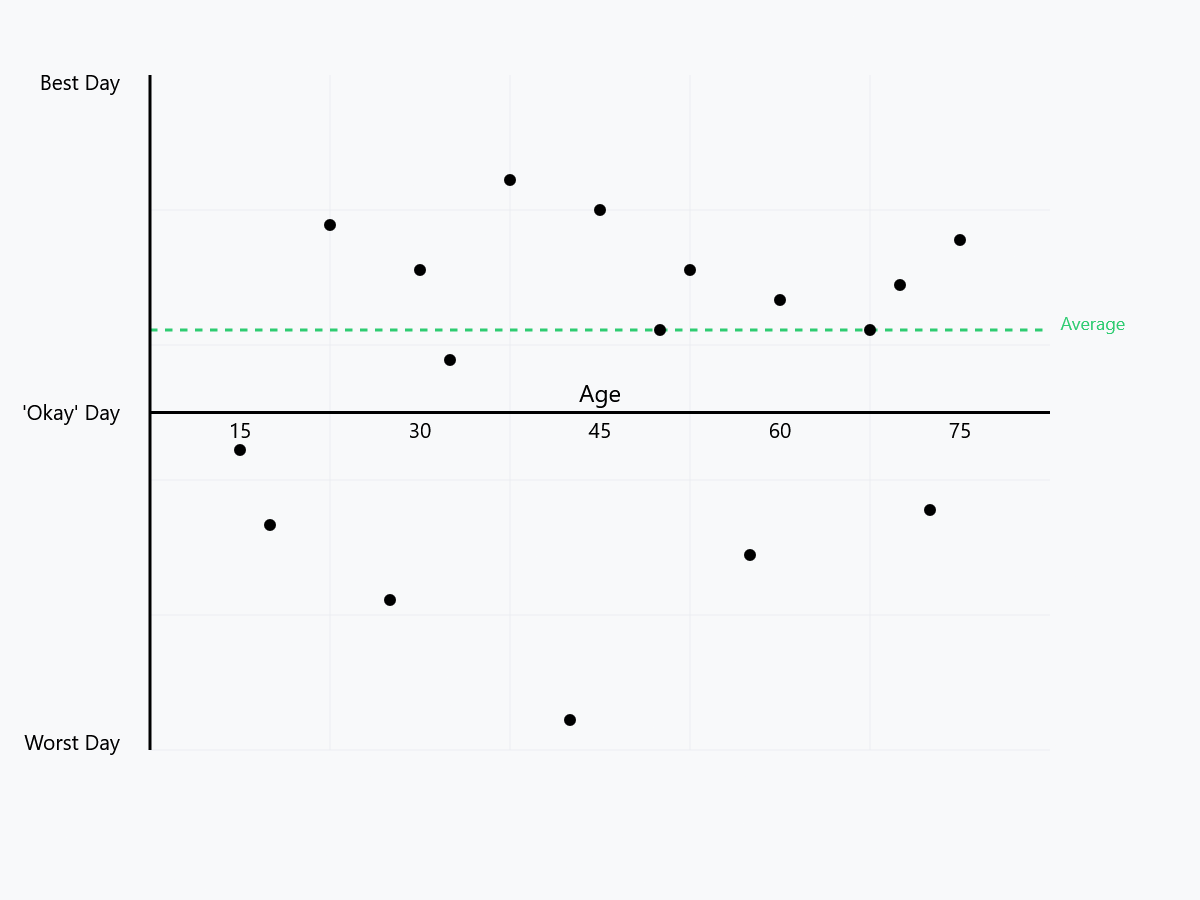Table of Contents
Things Aren’t Bad
Optimism motivates us to make the most of life. You wouldn’t work out if you didn’t think tomorrow was worth living. You wouldn’t have kids if you didn’t think the world would be somewhere you wanted your kids to live.
Yet, pessimism is all around us. News, social media, and changes in the economy make it easy to feel like there are only ever bad things happening around us.
Yes, some countries have declining birth rates, but developments in IVF and growing understanding of factors that impact fertility provide opportunities for those who could not previously think of conceiving.
Yes, Obesity is rising in the US and Europe, but accessible GLP-1 Agonists offer a promising solution, especially for those with genetic or hormonal challenges.
If you felt that everyday from today would strictly be worse than today, you would not have a reason to live.
I have an almost universal theory which can be summarised in two points:
An average day over the course of your life is more than just ‘okay’ (or more than ‘mid’).
The average day throughout your life gets better as you age.
Let’s start simple, everyone has good days and bad days.

Days of your life plotted from Best Day to Worst Day: this is just a graphical plot of the 'Year In Pixels' trend.
The above image depicts the days in your life - Some days over the course of your life are bad, these are the points below the x-axis (the horizontal line). Other days of your life are good, these are the points above the x-axis.
Now we can apply our universal theories to this graph and see what meaning we can extract from it, starting with: An average day over the course of your life is more than just ‘okay’.

Days of your life plotted from Best Day to Worst Day with a line showing the average across all of the days - It may not be mathematically correct, but it gets the point across.
As you can see, if we take the average of all the days in your life and plot it on the graph, it comfortably lies in the ‘good’ side of the graph. On average, you have good days in your life. In reality, this is very hard to quantify and measure and often relies on your gut feeling and self-talk to understand if you have more good days than bad.
If you currently feel like your average day is worse than ‘okay’, I will discuss ways in how that can be changed.
A different conclusion can be drawn if we apply our other theory to the graph: The average day throughout your life gets better as you age.

Days of your life plotted from Best Day to Worst Day with a line of best fit drawn - It may not be mathematically correct, but it gets the point across
At a younger age, everything is new, and everything is a first experience. From your first breakup, your first holiday with your friends, your first loss of a loved one, all of these are human experiences and your first experience of them is often the most difficult. As you grow older, you learn to navigate these situations and they (especially the bad ones) don’t feel as bad as they once did.
In addition, as you age, you are often granted more agency of your life. When I was 15, I could barely go out after school without giving my mum a full breakdown of where I was going, with who, and when I’d be back. Now, being older, I have my own agency, my own money, and I am able to make decisions for myself. This freedom and agency gives you a better satisfaction in your day-to-day life.
This satisfaction compounds with big decisions in your life, what you do for work, where you live, and who you spend your time with. These decisions are often the key factors in determining how good your life feels.
Changing Your Perspective
Experience
I touched on this a little earlier. The first time you experience something is typically also the time you feel the strongest emotions towards it. As a child, grazing your knee is scary; as an adult, you know you’ll recover.
On our graph with the dots, this looks like a transformation along the y-axis. Everything gets squished, the good becomes less good (but never bad), and the bad becomes less bad (but never good).

Here the black and red dots show the before and after of applying experience, respectively. The red lines are the averages mentioned before, adjusted for the red dots.
Depending on where your average day was before, this is either great or terrible. If your average day was good, your new average day is worse. If your average day was bad, your new average day is better.
But what if you could make good days great, and bad days less bad—or even good?
Gratitude
Without trying to sound like a mindfulness or meditation coach, gratitude is the easiest way to make the good feel great, and the bad feel good. This can also be summed up in two points:
When something bad happens, tell yourself: “It could have been worse. And now I am better prepared for if something worse was to happen.”
When something good happens, tell yourself: “I am lucky to be in a position to experience this. Not everybody gets to experience this so I should cherish it.”
When you apply these mantras (the meditation-adjacent language was not intended), good things feel better because you can appreciate that what you are experiencing may not be something everyone is able to experience.
Bad experiences also feel better when you realize they could be worse and that you’re now more prepared. If someone had told you as a child that a grazed knee would heal quickly, you’d have felt less worried. You may even feel more positive about the ordeal as you are now equipped to share the wisdom with others.

Here the black and red dots show the before and after of applying gratitude, respectively. The red lines are the averages mentioned before, adjusted for the red dots.
Being Present
Personally, I found it very hard to learn to be present. My mind would always wander to past situations to draw comparisons, or I would wonder if an opportunity like this would ever come again. What helped was a few things:
First was understanding that there are far too many variables at any given time for my current situation to be the same as one in the past or the future. It is impossible to track each variable and the impact it has in the current situation against past experiences. Instead, you can make a note of a few key variables (e.g., the time/place, who you are with, and how you feel) and do an on the fly ‘vibe check’.
Second was breaking down each situation (composed of the handful of variables) into emotions. It starts with asking myself, “how do I feel?” If I feel positive and I think I should feel positive (based on past experiences), then nothing more needs to be done and I can be present. When I started doing this, it was easy to fall into the trap of dwelling and no longer being present. Over time this became more of an instinct and becomes almost subconscious.
In the case that how I felt didn’t align with how I thought I should be feeling, I would try to diagnose it immediately. Was I feeling sick? Was something else from my day bothering me? Did I not like the environment or the company? Once diagnosed, I could make a decision if I wasn’t to remain there or not. But more importantly, I would recalibrate how I thought I should feel. This often happened on the journey home, or the following day. I would assess if my expectations were realistic and if they required adjustment.
Being present makes all experiences better because you are spending less time ruminating and more time making the most of the situation. On our graph, all the dots would shift upwards (and so would both of the averages).
My Own Criticisms
Time/Age
At the end of the day, I am very young. Only 26. My experience of this world is limited in comparison to people like my parents, grandparents, and even my siblings. It is very possible that my current perspective is due to my lack of age and experience.
As I experience more of what life has to offer, perhaps my perspective will change. I hope this piece of writing serves me in the future so that I may reflect as to why I held the views I did and how they may have changed.
Privilege
There are many things in my life that have afforded me the opportunity to develop the perspective I have.
My parents wanted me to succeed. I grew up in London, one of the world’s most diverse and well recognised cities. I studied at places where the teachers wanted us to achieve the best grades. I have friends from all cultures, backgrounds, and religions. I have worked retail/customer service jobs for places you’ve eaten at before and worked corporate technology functions for some of the world’s largest organisations.
I am not here to brag. I am only here to recognise that I know I have a level of privilege that others do not. And maybe that is part of the reason I write. To give those who did not have the same opportunity as me, a hand up to understanding not just the world, but themselves better too.
Conclusion
Life is amazing. It would be a shame if we failed to make the most of it, only airing our grievances at our younger selves when we are on our deathbeds.
For those with younger siblings, friends, nieces/nephews, kids, or even grandchildren, leading by example is the best way to inspire. We should all aspire to enjoy our day to day lives, ensuring it can be seen in our actions, words, and mannerisms so that those who follow in our footsteps may also live their lives to the fullest.
